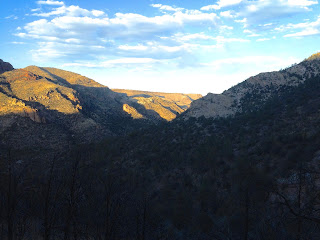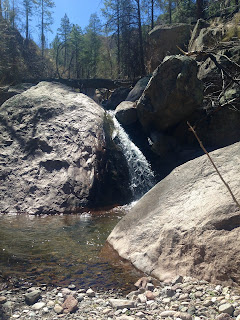Aldo Leopold Wilderness - West Curtis Canyon
 |
| Doug Scott took this one of me admiring the falls |
 |
| Las Animas Creek |
 |
| Las Animas Creek |
 |
| Smaller falls in West Curtis Canyon |
 |
| 100 foot falls in West Curtis Canyon |
 |
| These three rock fins are directly across Las Animas from the Curtis Canyon mouth. |
On Friday morning Doug Scott and I were off on another waterfall hunt, this time it was in West Curtis Canyon, twin brother to East Curtis Canyon that we had hiked to on Tuesday. All of my warnings regarding the East Curtis hike apply here, with the sole exception being there was very little thorny locust to deal with, however there is one extra caveat: this hike is not really a day hike. It's much too long and slow. It took us nearly 12 hours to go its 16 or 17 miles. It would be much better to explore both East and West Curtis Canyons as dayhikes, after having backpacked in and set up camp along Las Animas Creek. Problem is, getting to Las Animas itself is no easy proposition. It's probably a two day trip starting from the only maintained entry trails, either Railroad Canyon or the Crest Trail starting from Emory Pass( both can get you to start the Holden Prong Trail 114 which will take you all the way down to Las Animas Creek). Other options, such as Water Canyon Trail, or the Pretty Canyon, Flower Canyon route were not that great before the Silver Fire. It seems likely they are even less viable now. The section of Trail 307 from the pass southwest of Apache Peak down to Las Animas Creek ( which we used) can't be recommended either. We counted at least 13 washouts( some quite severe) that although we managed to negotiate with our daypacks, would pose a major concern to someone wielding a heavy backpack.

I met Doug at Mineral Creek at eight and we were soon off toward the Cave Creek trail head.The road there is in serious danger of washing out in several places. This was utmost in Doug's mind in getting out there again so soon. After this summer's monsoon rains, getting there by ATV( and being an expert rider to boot) may be the only( and perhaps not even an) option. We were on the trail at 8:50, a full hour earlier that our departure to East Curtis Spring, which was a good thing, but did not prevent us from walking back the last hour in the moonlight.The first section of FT 307 was great as before, but beyond the saddle it was different story. Besides, the aforementioned numerous( and treacherous)washouts, the tread is disappearing from lack of use. Dead and burned trees were obstacles as well, although we cleared as many as we could. It's a shame, because, on a previous hike many years ago going down this trail provided a quicker, relatively easy, and scenic entrada to the Animas Country. It's still scenic:the canyon it follows is still mostly green having experienced only spotty burning, with fantastic views of the Las Animas valley, the rugged mountains above it, and of Apache Peak as well, but the washouts were a problem then and are still one now. In few years, without use or maintenance this section will become little more than an idea, the thought, that a trail was once there.
At the bottom, Las Animas Creek was running cool, clear and about 10 inches deep in a wide corridor of burnt and dead trees standing in the thick growth of yellowed grass. The road that once ran through this valley is fast disappearing as well, but we still followed it when convenient. We tried to put the pedal to the metal, but despite this section being more or less flat, the numerous stream crossings, soft sand on the banks, and the searching for the road, left us making average progress at best.
The Dunn Place and the Kelso Place both had beautiful meadow areas and I imagined them both green and lush as I saw the beautiful Murphy Place further upstream 7 or 8 years ago. An impressive box section along the way had towering cliffs, and miraculously, bits of green pine forest with some truly huge trees. On the eerie side of things, there was a forest of burnt live oak trees with twisted gnarly limbs of black reaching in all directions.




 We stopped briefly at the plaque and white grave markers, now half buried in sand that flowed out of a side canyon, that are there for those soldiers who died in a battle with the Apache warrior Victorio in a nearby canyon. A tattered rag of an American flag flapped in the breeze.
We stopped briefly at the plaque and white grave markers, now half buried in sand that flowed out of a side canyon, that are there for those soldiers who died in a battle with the Apache warrior Victorio in a nearby canyon. A tattered rag of an American flag flapped in the breeze.
Soon afterwards, we saw a side channel joining Las Animas Creek on the south side, which we knew to be the combined flow of East and West Curtis Canyons. There was zero indication of the trail that once began here and headed up East Curtis, but the going was relatively easy up to the confluence of the two canyons.
 |
| Confluence of East and West Curtis Canyons |
Heading up West Curtis almost immediately became a serious scramble through boulders, on ledges, in the loose dirt on the hillsides, around many smaller waterfalls and in the stream itself. The progress was slow, and I despaired of eventually being blocked out of seeing the high falls altogether. Along the way, I noticed an impressive riparian area still survived in the narrow north facing canyon. There were massive alder trees, chokecherry trees with their blossoms just fading( and one small one already leafed out), and abundant gambel oaks that were just beginning to bud. There were also evergreens: douglas firs and ponderosa pine that had made it through as well. There was burning here as well, because it seemed every other tree I reached out for would leave charcoal stains on my hands, but it wasn't anywhere nearly as severe as the Las Animas valley, East Curtis, or the nearby mountain tops, and high plateaus.


Finally, we came to the two falls just below the high falls: a wide 30 or 40 foot shimmering cascade that spread the flow of a three or four foot wide( and 25 foot high)pour off just above.

We left our packs behind for the improbable last pitch up a dirt and gravel chute that afforded us safe passage up the left side. I felt like a new man without the weight of my pack and we climbed up easily and then made our way down easily as well. The falls winds blew as they did at East Curtis, and temperature dropped at least 10 degrees or more. I was even a bit chilled, as I stood on the shore of the large pool beneath the magnificent 100 foot falls that streamed down the sculpted rock face before me.

I thought, in my neurotic way, what a strange place it would be to come to if the water wasn't there. But it was there, and it flowed and flowed. After the droughts, and after the fire and floods, there was this clear, cool flowing of water. I imagined a place in a more rain or snow blessed part of our country. It's hard to believe, even for me as I stood there that this place, perhaps 10 miles as the crow flies from the desert, could exist with the sound of the cold, last of snowmelt, mid-March stream rushing, falling and ringing in my years. Loud enough that we had to shout and still couldn't be heard until we retreated lower down and ate our lunches.
The way back down was slow, almost as slow as up, and rough. At one point we traversed the divide and hiked down into East Curtis to avoid a difficult climb down. We immediately found a 20 foot waterfall over there, which alerted us to the potential of the unexplored stretch of that canyon.
 |
| 20 foot falls in East Curtis Canyon |

Note: If you haven't figured out yet, this hike, scramble is not only extremely strenuous, but requires a significant investment of time in researching all aspects of the area to insure success.
Labels: hiking, waterfalling















































